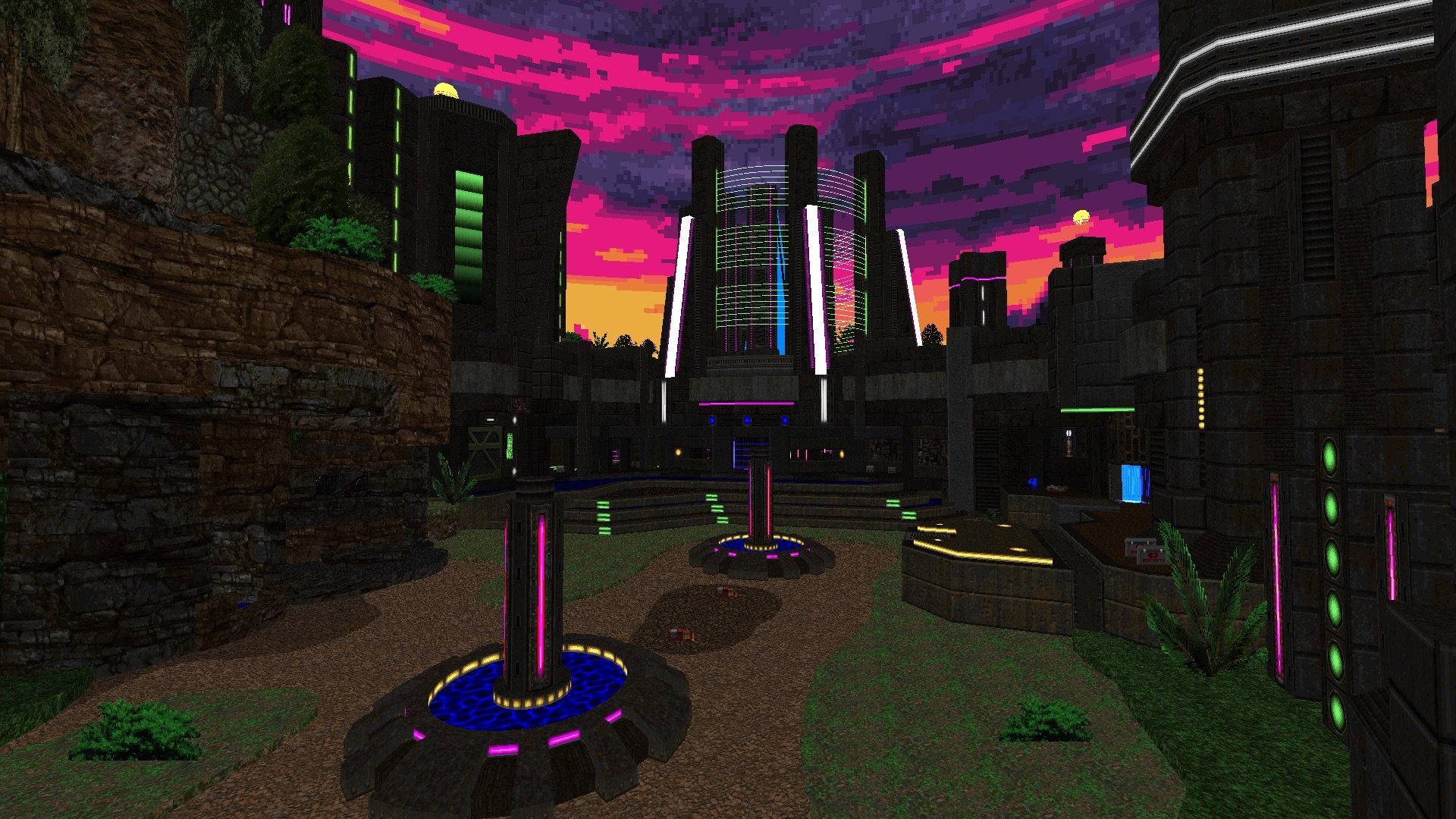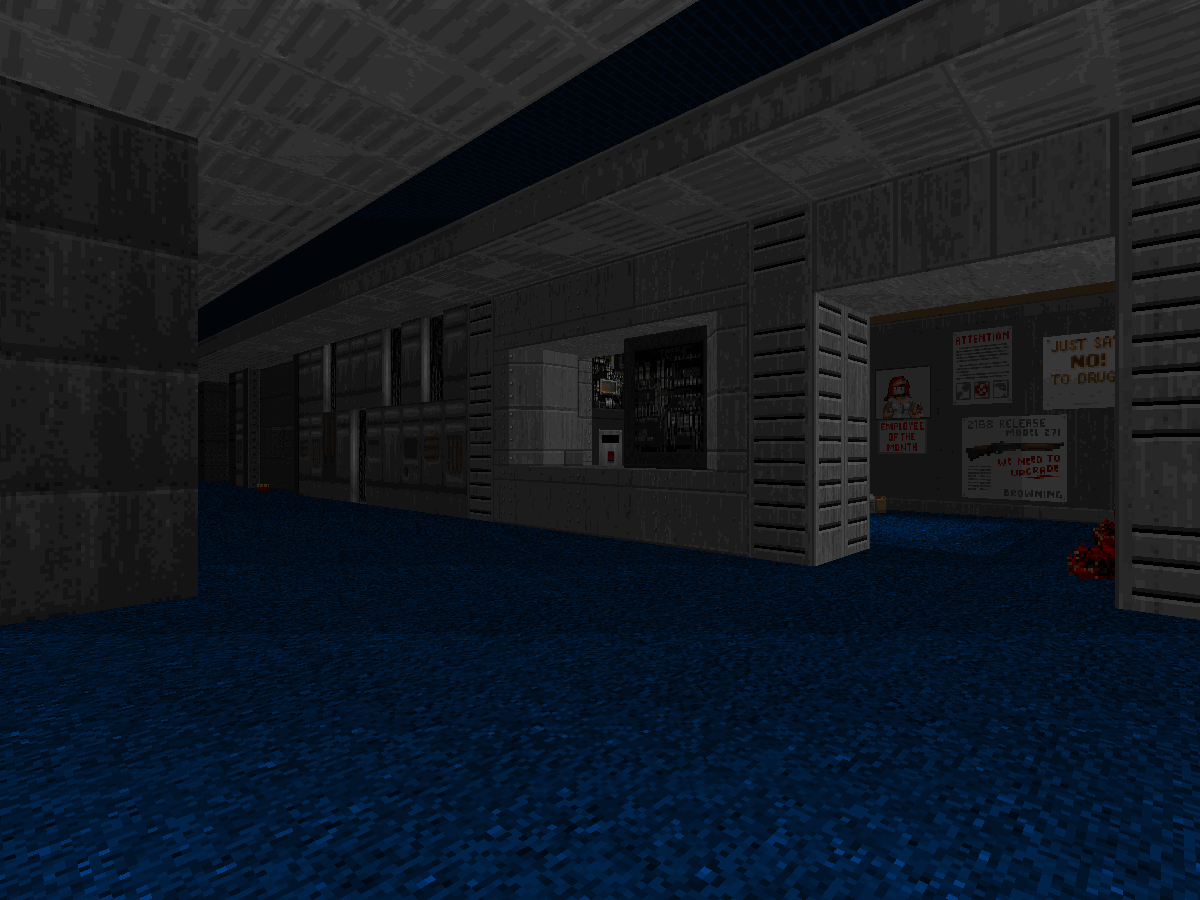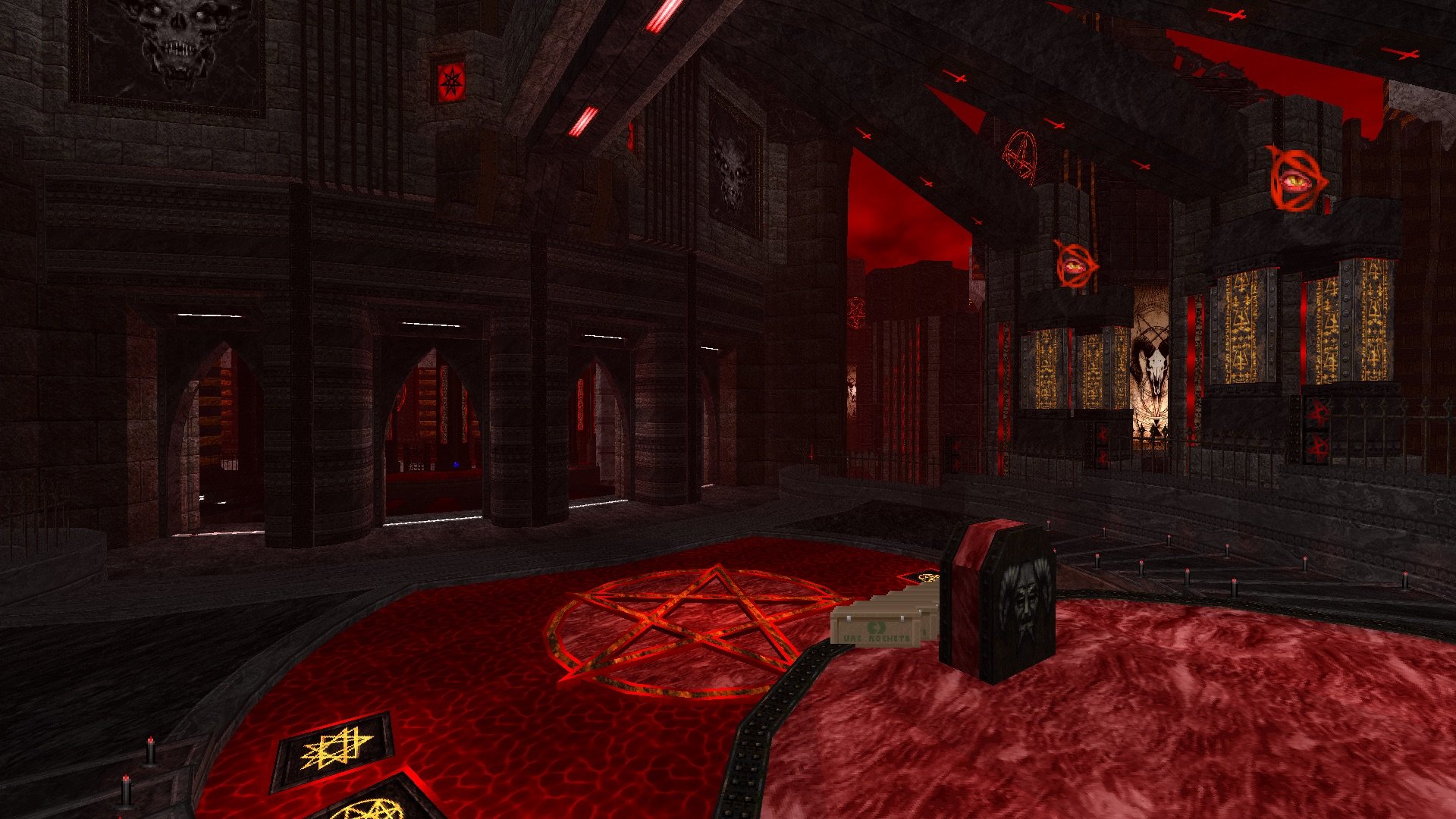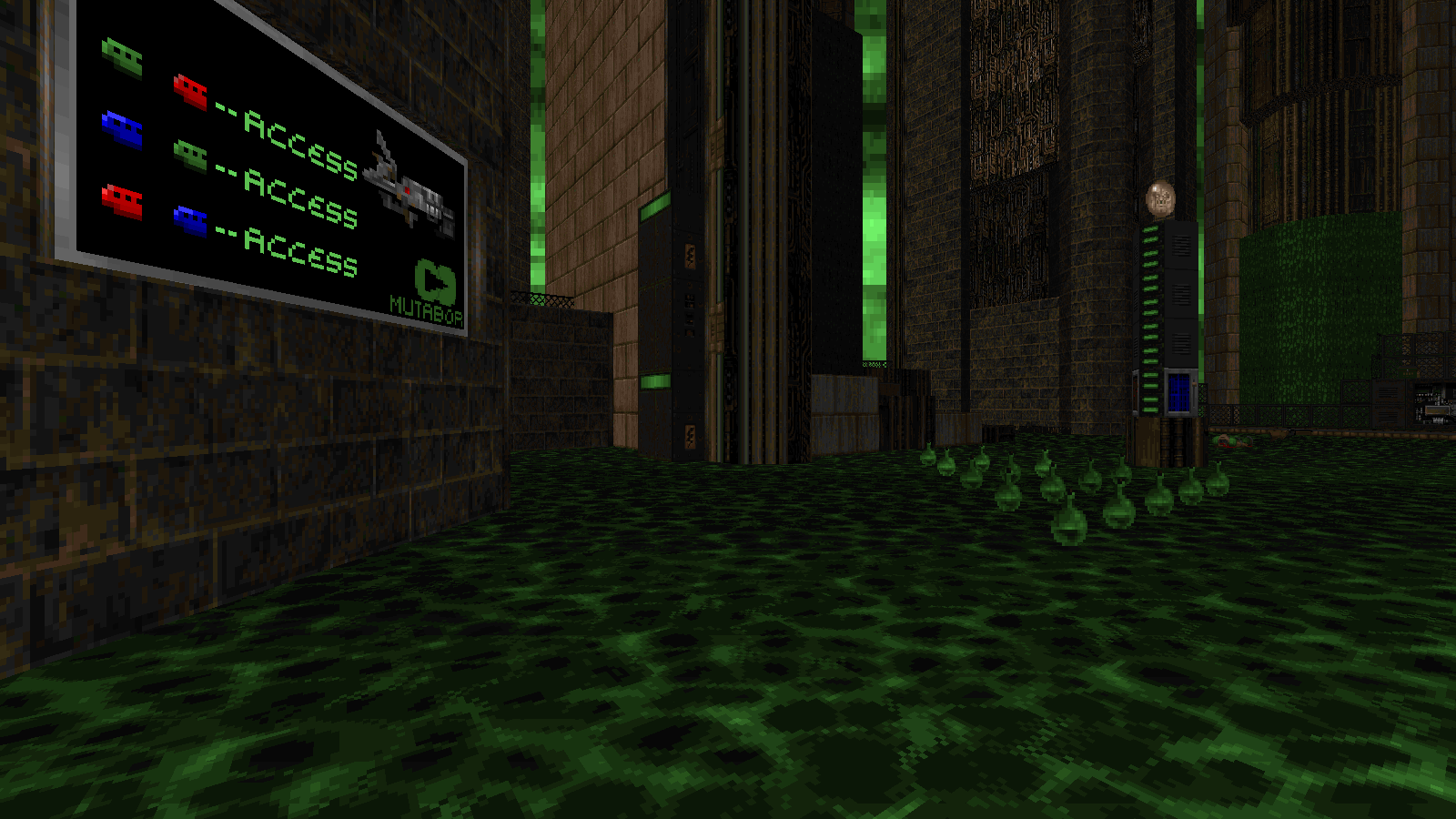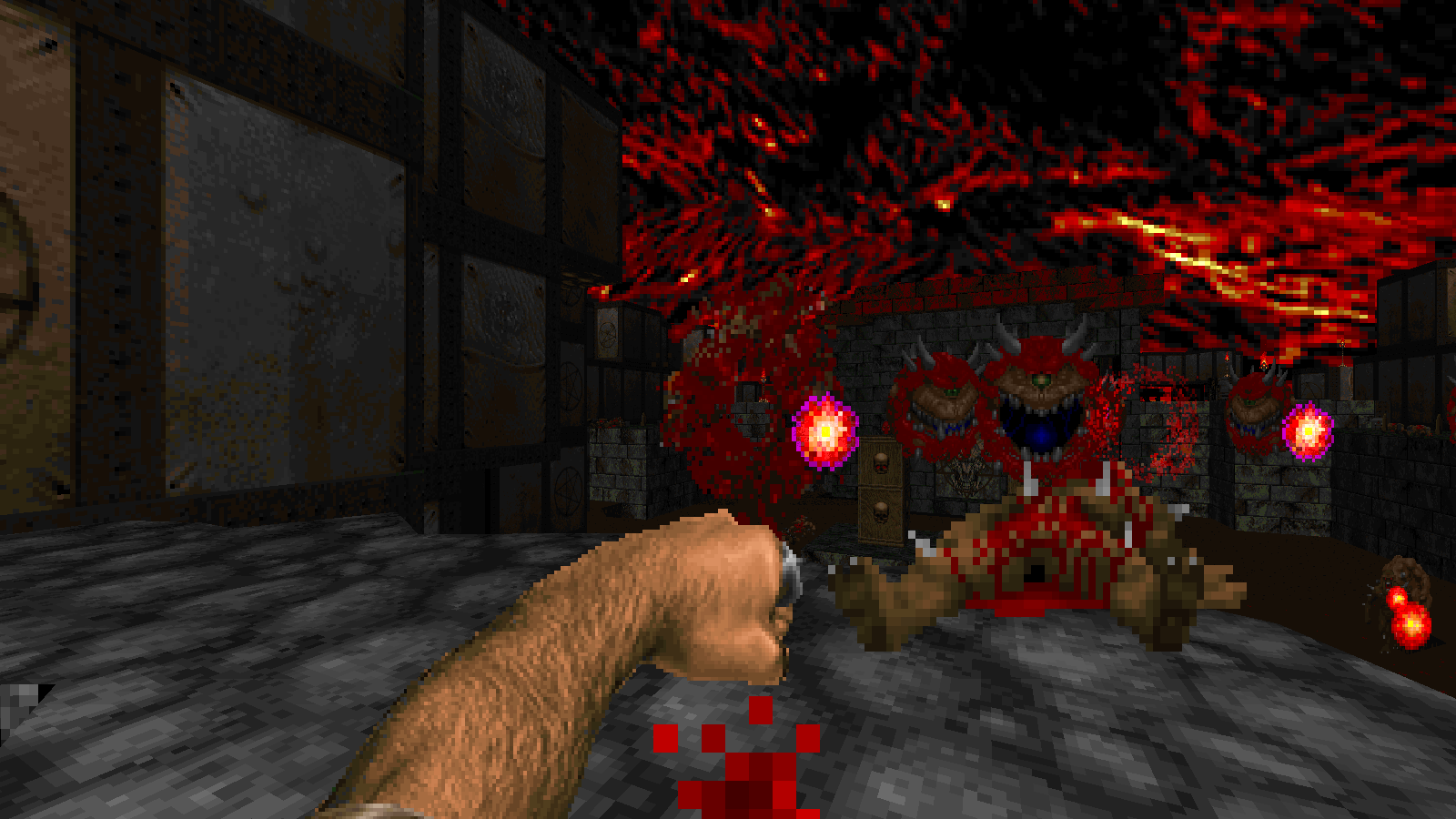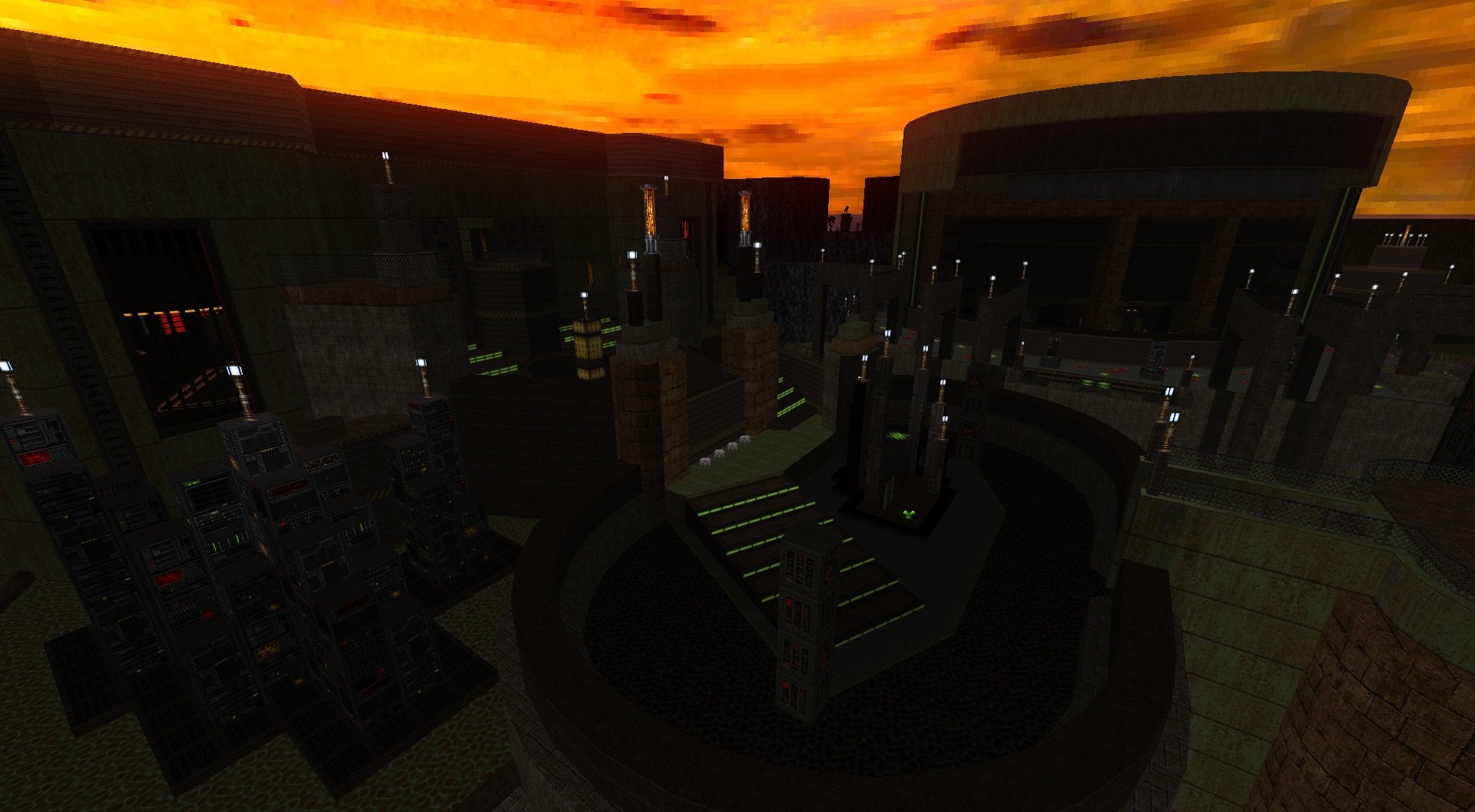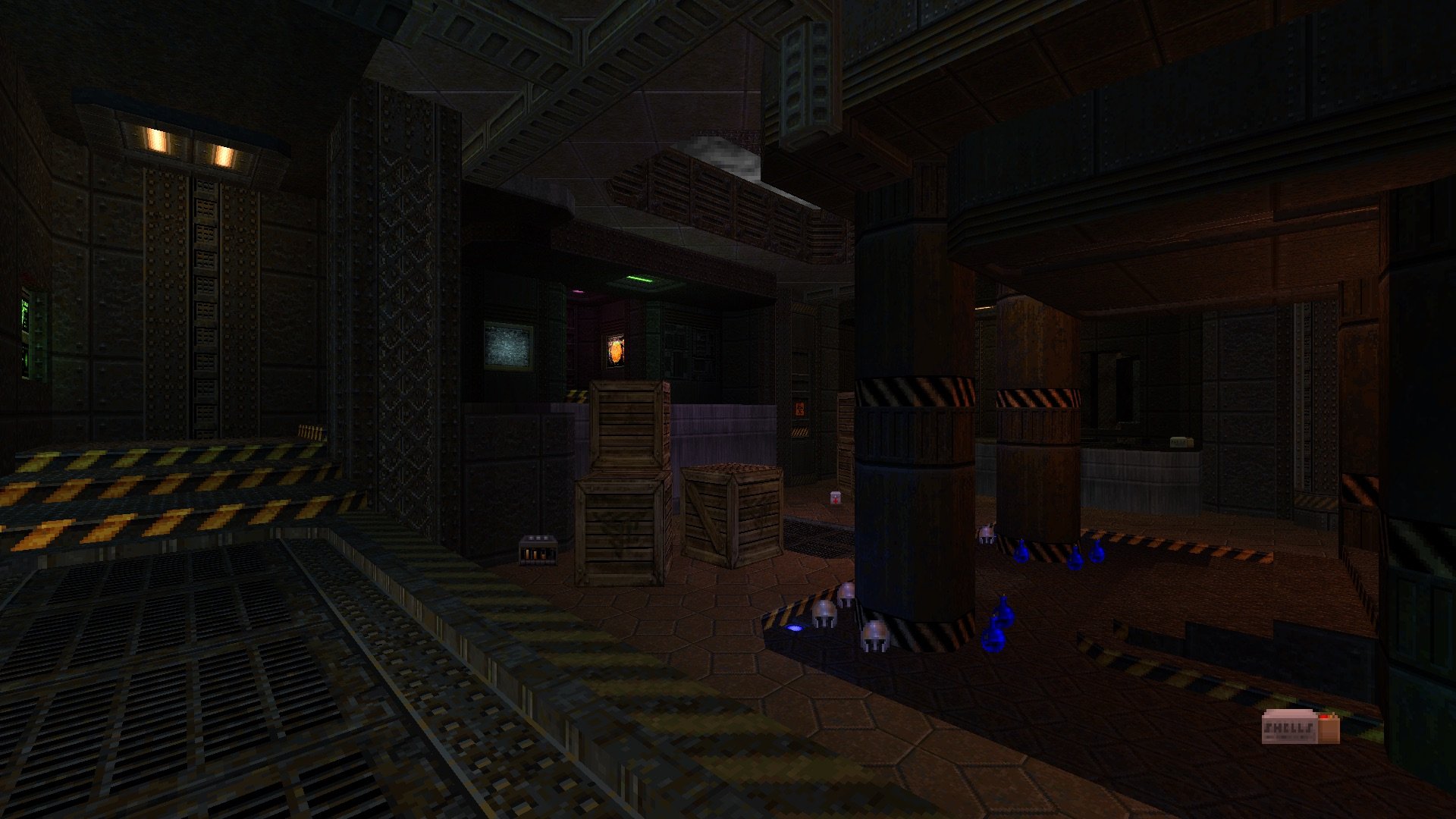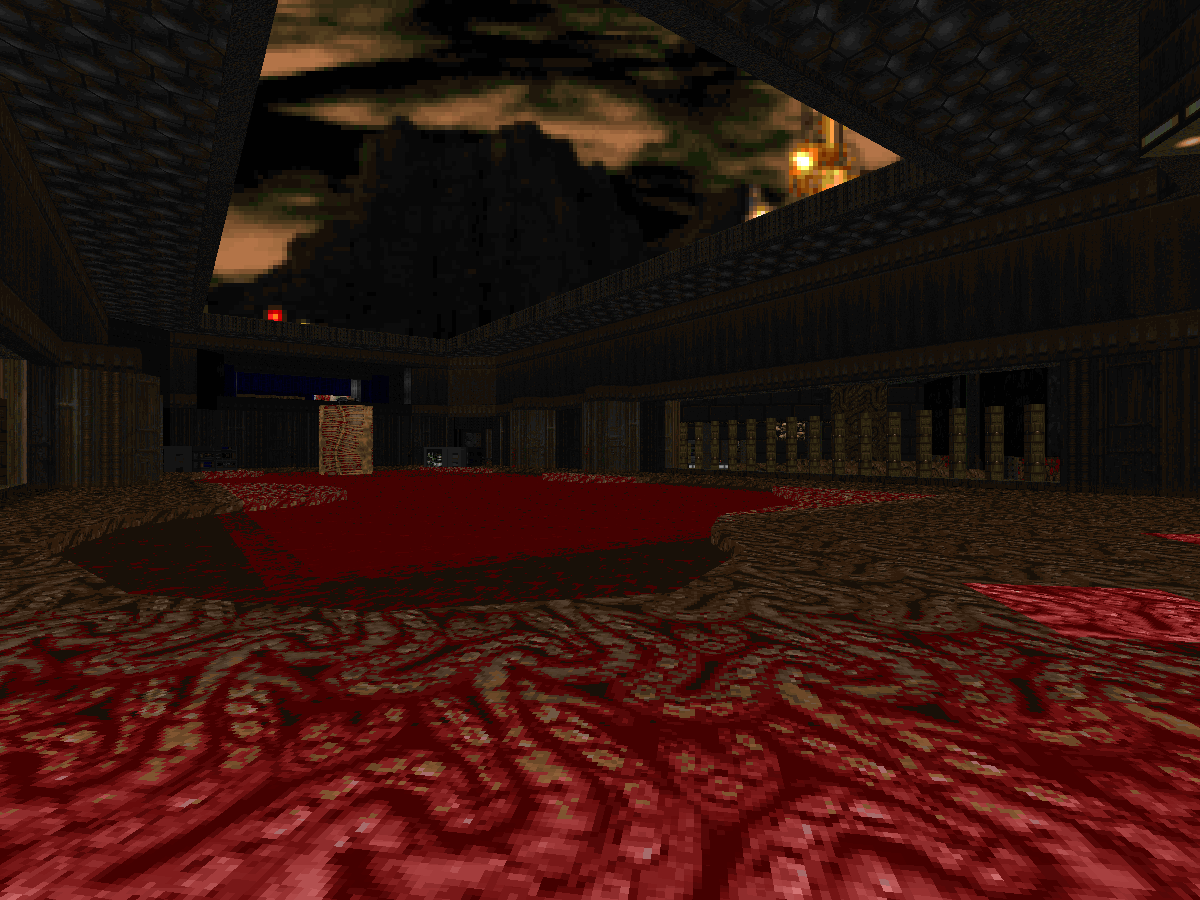-
 Ar Luminae - @Aurelius and @JustCallMeKaito
Ar Luminae - @Aurelius and @JustCallMeKaito
Doom 2, GZDoom, 1 map
Ar Luminae (which is Space Latin for “aesthetic as fuck”) may well be the largest and longest mainstream Doom map ever made, and let’s be real for a second: as far as most players will be concerned (including your friendly neighborhood award judges), that is a strike against it. It would be easy to hate this map if it weren’t for the incredibly cool setting, stunning architecture, unique and thought-provoking combat setpieces, great new high-powered guns, unique visual centerpieces, dazzling use of color, engaging storytelling, clever secrets, surprising sense of humor, smart and otherworldly use of advanced features…well, you get the idea.
The map begins in the friendly, peaceful confines of a space station, tantalizing you with a mission briefing, a half-dozen closed portals, strange machinery you can’t activate yet, and a mysterious, lethal-looking exit mechanism before beaming you down to the surface. What comes next can be best described as one of the greatest key hunts of 2020; more akin to an easter egg hunt than anything. Only the easter eggs contain either a fine assortment of cordials or the highest-octane moonshine bootlegged from whoever decided that you really, really needed a taste of that sort of thing. Among sweeping cliffs, deadly craters, dim caves and monolithic structures, the scene is set to be non-stop chaos.The map centers around a volcanic desert surrounded by towers of bricks, and branches out into pathways marked by neon strips to guide the way.
Among the usual Supercharge shenanigans, there’s a few new shiny toys that you’ll find along the way. In order to really increase the DPS, Ar Luminae adds a quad damage power-up, and three new weapons: a vicious minigun, a railgun, and what’s only described as the Stomper. These aren’t added just for the fun of it—you’re going to need these bad boys in order to fight your way out of the vast numbers of demons that you’ll be facing.
All of this leads up to one of the most strenuous boss battles made possible in Doom. Tucked away in a tower surrounded by mysterious floating lights, a neon ball of demonic energy awaits, spawning mountains of demons to try and kill you. But you’ve gotten this far—there’s no going down without a fight. Your steps must be swift and sure, because the tower will not yield to you without the movement of a series of floating walkways and switches. Keep your big guns steady and your trigger finger down, because it’s non-stop chaos all the way to the end.
The incredible ambition of a map like Ar Luminae is evident in all the ways that it succeeds and the ways that it struggles to completely fall into place, though its successes are both numerous and eye-opening. Navigation can be rough at times, and the nonstop intensity of its 3+-hour duration (even on HNTR) can not only be wearing but also can work against the things that are most compelling about the map, such as the player’s ability to slow down and explore or take in the beauty of their surroundings. But while I’d approach it with some caution, the wonder of exploring an entire planet and the spice of the experiences you’ll have along the way make it a treasure trove that’s hard to pass up. And whether you play for a challenge or for the chance to be immersed in new and fantastic settings, Ar Luminae will show you many of the coolest things you’ve ever seen in the Doom engine.
- @Not Jabba and @Major Arlene
-
Doom 2, Boom-compatible, 18 maps
If you've ever had a job with a lengthy commute, you know lots can go wrong heading there: a traffic jam, a pounding headache, a relentless demonic invasion that threatens to leave the whole planet a scarred, lifeless husk—or, worse, maybe you overslept and had to rush your shower. Sometimes stuff just happens. Unfortunately, for most people in the current global economy, days off are an unthinkable luxury in the face of common hassles. So you roll up your sleeves, adjust your heels, and get on with your day.
As the protagonist of Running Late 2, A2Rob's sequel to a very promising first mapset, you find yourself in this unenviable position: a security guard starting a new job after their old workplace outright blew up. (Escorting out a misbehaving Icon of Sin is always dangerous.)
You can think of Running Late 2 as a screwy spin-off of early 2010s hits like Vanguard and Resurgence. It has the blocky architecture, the cheery popping colors, and the simple eye-pleasing shapes, which all combine for a comfy lo-fi look. Usually that mode is geared towards abstraction—areas that are "video game spaces" instead of representing anything too specific—but A2Rob's unusual move was to pair that core with a playful narrative and a heavy dose of environmental storytelling. Along with the cleanly designed abstract spaces (there are still lots of those), you tour areas like conference rooms, looping highways, and kendo dojos. If you didn't pack breakfast, you might be teased by soda machines, cups of coffee, and...giant fish. This synthesis fits common wisdom: despite over a quarter-century plus of fan-modding, a whole lot of formulas, many that wouldn't seem too alien, haven't been mined much. You can put a new twist on anything. You can twirl it until it becomes a chaotic mess that accretes back into something cool. A lot can be said for plunging into the unknown, even if that's right next door.After storming through oil rigs, rail stations, and carpeted headquarters—where one moment you are fending off gaggles of belligerent revenants and hell knights who had no scheduled appointment, and another you are looking at really cute "employee of the month" posters—you eventually make it downtown. Here, a lot of the megawad's traits and tropes melt into a high-octane big city brawl against the worst of hell, from street-sweeper Spiderdemons to hundreds of Imps you can pulp into gib smoothies. Running Late 2 takes cues from the crunchiness and player-empowering intensity of early skillsaw, and serves up all sorts of pressure cookers and freewheeling brawls. The demons are as likely to be asshole supervisors, lording over you with tactical advantages (and knowledge of your browsing history), as they are to be comically inept popcorn that melts to your big guns. But be wary. The moment you take a gang of basic zombies too lightly is when they get incensed and papercut you to death.
At the end, you're a lone nighttime worker in a faintly lit grid of cubicles, hunched over a computer that just crashed. It is quiet and still and empty, well, except for that giant fleet of Imps pouring in. There has been a minor security breach, and you're on the clock. But even after you clear out these nincompoops, your job isn't done. Rip and tear...a shitload of old invoices. The only way out is through...Mike's cubicle (and he's an asshole).- @rd.
-
 Bastion of Chaos - @Bridgeburner56
Bastion of Chaos - @Bridgeburner56
Doom 2, GZDoom, 1 map
Bridgeburner is the Martin Luther of slaughter; rather than reform the proud old Church itself, his theses have swept through the laity like a seismic armageddon, altering the landscape of the mapping community and creating entirely new institutions in his wake. The demographics of the community have been shifting for years as players of the new Doom series cross over with retro indie fans and find themselves drawn to classic Doom. More than anyone else, it's Bridgeburner who has defined a voice for that new influx of mappers—a style that draws on the graphical achievements of modern video games and the brutal intensity of id’s latest creations.
This style is—obviously—inextricably rooted in GZDoom, the most advanced and feature-complex source port, but if you thought The Slaughter Spectrum was “just the same thing with fancier lights and floaty 3D shapes,” then you haven’t the foggiest idea what the new movement is capable of or how deep the rabbit hole has already gotten. The magic of Bastion of Chaos is in Bridgeburner’s mastery of the port in all its intricacies. Layers of 3D architecture are woven through superstructures with Mechadon-like finesse. Sweeping arches and angled buttresses create a wider variety of shapes and profiles. Subtle fog and coloring create a stronger sense of depth, grounding different tiers of architectural formations across the distance as your gaze takes in the massive scale of any given view. It’s an aesthetic that offers just as much as the classic god-machine abstraction of Abandon and its predecessors—more elegant and rich, less surreal and unfeeling, but equally imposing. Bridgeburner has opened up more gameplay possibilities as well. Here is a style of slaughter where jumping is not only allowed but fully accommodated, and often an important part of survival. Pain Elementals are used with a full understanding of the tactical scope and increased threat they create with no Lost Soul limit—something that hardcore combat designed for classic ports has always ignored out of necessity. Even the glorious 11-minute .OGG soundtrack shifts dynamically to hit its high points during major battle sequences thanks to scripting.
The all-out nature of the level design may go hand in hand with the mythic intensity of the battles, but the other major tenet of Bridgeburner’s philosophy is broader accessibility. Bastion’s UV has the appeal of being god-tier, but it’s an experience best left for gods to enjoy; for those of us who might find it grindy and unpleasantly hardcore, the lower settings are painstakingly designed to offer different experiences that appeal to distinct sets of players. I would strongly recommend the vast majority of people play it on HNTR, as I did. The doors are left wide open for players of lower skill to approach the map as a mountain to climb, and have fun doing it—and for many people who have viewed the slaughter genre as an intriguing but distant and exclusive sort of paradise, I think that is what they’ve always wanted.
Bastion of Chaos improves over The Slaughter Spectrum in every possible way. Its combat is more advanced and thrillingly immersive, its aesthetic style stunning and distinct. With its philosophy so clearly defined and the congregation of the new church growing by the day, I can only imagine that this is the beginning of something truly exceptional.
-
Doom 2, vanilla / DeHackEd, 1 map
Not so much a sequel as a spiritual successor to 2016's Miasma, Tourniquet's Mutabor is a meditative sojourn amidst the skeletal skyline of an unnamed civilization fallen victim to a hubristic lack of contingency planning for such mundane post-industrial inevitabilities as leaky pipes, substructural subsidence, and aggressive insurgence by carnivorous horrors from beyond the veil. All slimefalls, silent smokestacks, and decaying skyscrapers teetering like so many precariously placed Jenga blocks, one does not simply walk through Mutabor's world; rather, you tend to plummet through it, ever deeper into its murky depths, only to find yourself climbing back above the clouds sometime later, often ending up a stone's throw away from where you began, as the crow flies.
In this, Mutabor represents the culmination of a design philosophy which its author has been experimenting with for some time now, whereby the core of the game is made more by the environment, and the player's navigation of it, than by the artifacts and creatures it hosts. This is not to say that there's no visceral action to be had, mind; biomechanical apex predators are ever-lurking and ready to strike at critical moments throughout the journey, and bloodthirsty mobs can emerge seemingly from nowhere through sly structural shifts, particularly in the deeper reaches. Yet, even at its most intense, the action takes on a primarily ambient role, serving to underscore the radically vertical geometry, and to act as a breadcrumb trail through a deeply non-linear layout hosting dozens of overlapping and intersecting progression strings, three distinct yet carefully interwoven paths to the exit, and a wealth of hidden areas and optional exploration.
Yes, this can all be rather bewildering, and becoming lost at some point is, for most players, all but inevitable. But therein lies the beauty: while the grand scheme of the map can be difficult to see until after the fact, progression in the moment is almost never a hassle, being meticulously crafted to respond dynamically to the unique travails of each player, from those as surefooted as mountain goats who'll stick entirely to the high ground, to the most avid spelunkers who will insist on stepping off of every ledge as a matter of principle. It's a very complex and challenging environment to navigate and keep one's bearings in, true, but also an equally inviting and flexible one, as there really is no wrong way to go about plumbing its many secrets.
This essential mutability extends even to the in-game skill settings themselves. Rather than approaching this in the typical way, where each setting is a nominally more or less challenging iteration of a single adventure, Tourniquet has ingeniously used each of the three "core" settings to present three markedly different experiences, via drastically altering not only item and actor placements but also the player's starting point in the map. HMP, the default setting, is the most openly approachable, offering an empowering lean towards heavier weaponry and almost immediately positioning the player at a nexus with boundless progression choices. UV, interestingly, is more of a longform/slow-burn experience, starting the marine at a remote point on the periphery and initially emphasizing methodical exploration and secret-hunting before eventually escalating to serious fireworks by journey's end. HNTR, normally the "easy" setting, has been replaced with "Onslaught!" mode, which sees a minigun-wielding protagonist deep in the ruins attacked from all sides from the outset, the smoggy air soon thick with the stench of blood and cordite.
Concluding with a short puzzlemap, of all things, as a quirky coda, Mutabor is an engrossing and inspiring example of what is possible in classic Doom level design, and a trip worth taking again and again.



